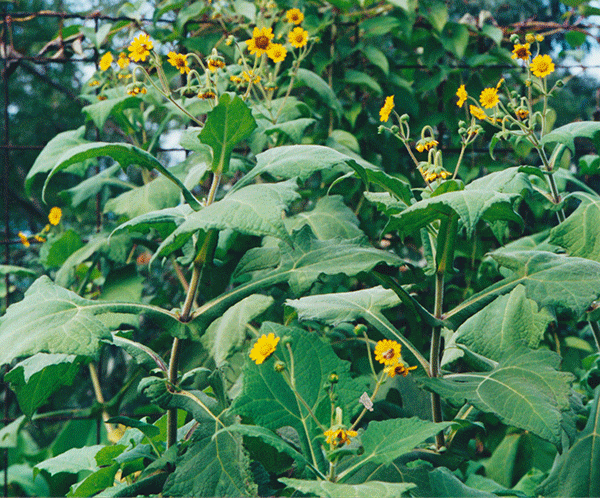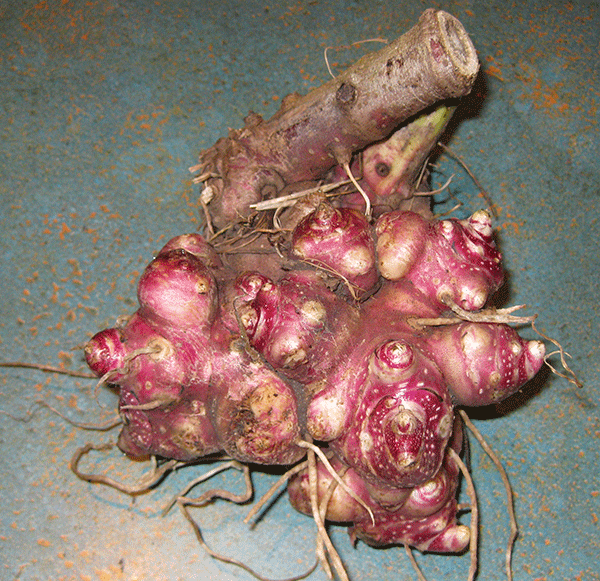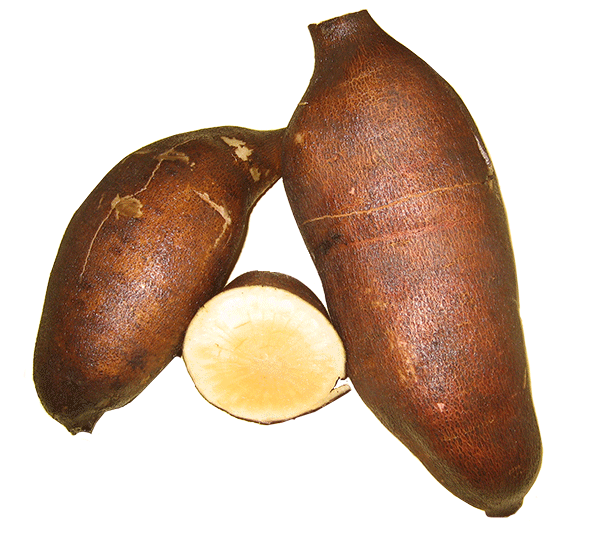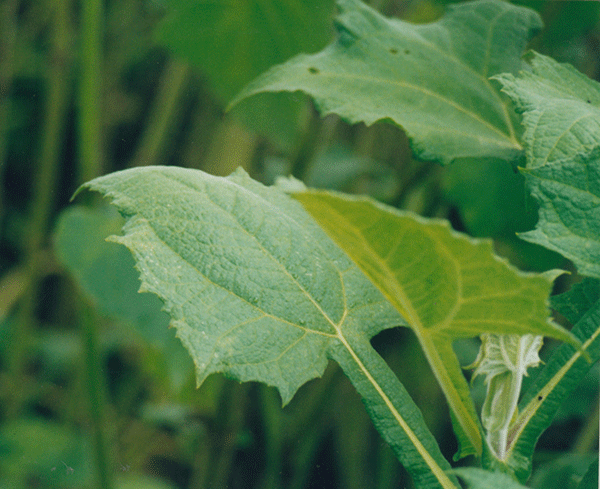A winter treat – Peruvian ground apple
Yacon – otherwise known as the Peruvian ground apple, strawberry jicama, Bolivian sunroot, llacon, sweet-root and ground pear – is ready to harvest now. We eat its sweet, juicy tubers raw, cooked or added to juices. I love this winter sweet treat with its great crunchy crispness; it tastes to me like nashi pear and can be used to create great meals. It also works well as an animal forage plant. The plant looks good in the garden too, with little daisy-like flowers. The edible tubers (there are two types of yacon tubers, those for propagation and those for eating) resemble dahlia or sweet potato tubers. They weigh on average around 300g but can reach up to 2 kg: enough to feed all of the family and the neighbours as well!
The Yacon is easy to prepare but it’s worth noting that there are two ‘skins’. I remove the outer brown skin and inner white skin by peeling with a knife – the skin has a resinous taste – to reveal the amber coloured, sweet crunchy flesh. I treat this plant both as a vegetable and fruit. Try it sliced with orange blossom water sprinkled on top for a refreshing dessert, cut into chunks and add to your Waldorf salad instead of apple, or dip it in melted chocolate for a real sweet treat. Just a hint – if you are not serving it immediately after peeling, soaking in lemon or vinegar will stop the Yacon oxidising.
Yacon is so versatile that it can also be boiled, steamed or baked with other vegies. Cooked, they stay sweet and slightly crisp. If boiled ‘in the jacket’ the skin separates from the flesh and can be peeled off like a boiled egg. Yacon can also be used in a dessert crumble or pie with apples, pears or choko. The tubers juice well in an electric juicer and I use them to sweeten other juice combinations as well. The young stem can be used as a cooked vegetable.
Here’s a great spring recipe for organic fruit and veges:
Sweet Spring Juice
- 2 medium peeled yacon roots
- 1 large carrot
- 2 green apples
- ¼ of a small cabbage
- 1 large stick of celery
Method
Process the fruit and vegetables in an electric juicer. You can add or reduce ingredients to suit your taste.
The other great thing about Yacon is that it’s low in calories. The tubers store carbohydrate in the form of inulin, a type of fructose, which is a suitable food for type II diabetics. If you don’t want to eat it yourself, Yacon has potential as a forage crop for animals as the leaves have a high protein content and when cut, the foliage sprouts again from the underground stems. The tubers may be a good cattle feed: inulin is rapidly metabolised by ruminants. What a plant!
Tags: animal care, cooking, drinks, fruit, livestock, roots, vegetables
Posted in Kitchen







Hi! Are these plants invasive, or require a lot of space and how do you grow them?
Marga
I have grown them for 20 years and never had one self-sow. They also are easy to lift and harvest without leaving small tubers and rhizomes behind. For this reason they do not pop up later as Jerusalem artichokes tend to do in cooler areas.
So definitely not invasive. Detailed growing information here http://greenharvest.com.au/Plants/Information/Yacon.html
I’ve been wanting to try Yacon for a while now! Do you know if there is anywhere on the Sunshine Coast I can buy some?
Green Harvest has it available from July to September but order soon! http://greenharvest.com.au/Plants/SweetPotatoToYam.html#Yacon
Will Yacon grow in the tropics?
Yacon is day-length neutral so there is no reason it shouldn’t grow in the tropics but I have not actually heard whether it does or not. http://greenharvest.com.au/Plants/Information/Yacon.html
Your spring juice recipe sounds delicious! I will have to grow some of these amazing tubers.
@Bonniep yes Yacon grows in the tropics, I just had vacation in the Philippines and my mother bought us Yacon for the first time. We ate it like eating raw sweet potato and it’s yummy sweet crunchy taste!
I’m going to try to grow it in Wyoming! 🙂
I’m lucky enough to have been given a harvest of yacon tubers for replanting. Before deciding where to plant, do you know if wallabies will graze on the emerging shoots if I don’t protect them with a barrier? Thanks.
Luckily yacon doesn’t appear to be in the wallabies rather broad list of forage plants.
Can yakon leaves be eaten? If so, can it be added to salads or stir fried or ??. Please advise.
Thanks
Sharon
Email address- sharonlnti@yahoo.com.au.
I would like to buy some Yacon – otherwise known as the Peruvian ground apple about 20 – 30 plants could you send me a price. Thanks